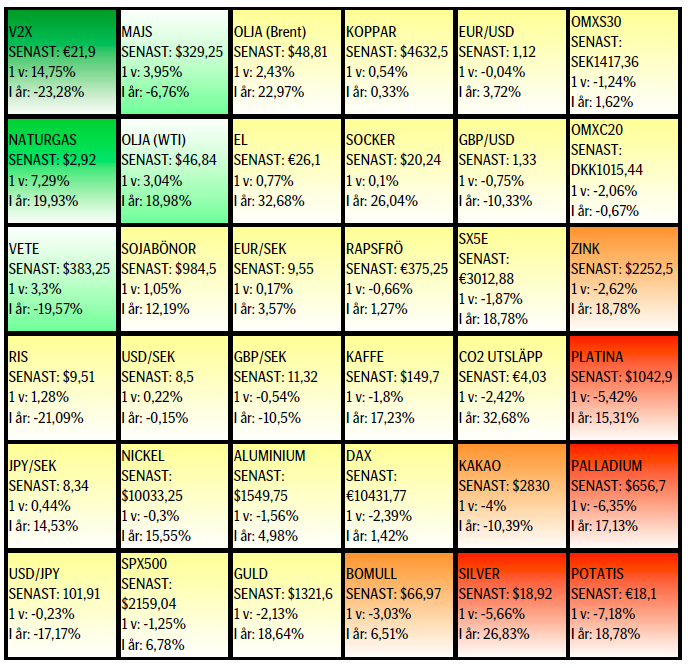Analys
SEB Råvarubrev 13 september 2016

 Volatilitetens återkomst?
Volatilitetens återkomst?
MARKNADEN I KORTHET
Efter en av de längre lugna perioderna i S & P 500 (mätt som 20dagars glidande medelvärde +/- två standardavvikelser) invaggat investerarna i en kanske för trygg förvissning om en fortsatt likartad utveckling bröt kurserna ned på bred front under fredagen. Volatilitetsindexen blev följaktligen förra veckans vinnare. Ytterligare oro, åtminstone på kortare sikt, kan definitivt inte uteslutas. Även råvaror påverkades generellt negativt av det mer negativa sentimentet. Det mest oroande tecknet är att svagheten i aktier och råvaror denna gång inte lett till fallande räntor, tvärtom så har internationella obligationsräntor stigit relativt kraftigt.
Råvaror: Oljan fortsätter som planerat sitt meandrande inför det informella OPEC mötet i Alger senare denna månad. Irans oljeproduktion har planat ut och gjort så på samma nivå man låg på när sanktionerna trädde ikraft vilket gör att man nu bör ställa sig frågan om de nu nått sitt kapacitetstak. Amerikansk naturgas fortsätter att klättra allt högre. Basmetallerna, framför allt aluminium och koppar har fortsatt att handlas ned men har nu även fått sällskap av nickel och, äntligen får vi väl säga, zink. De pressade jordbruksprodukterna, majs, vete och sojabönor har alla stigit den senaste veckan och i fallet vete kan det vara så att vi är på väg att nå en balans. Kaffe fortsatte initialt upp men mötte, precis som i juli, säljare över 155.
Valuta: Dollarkursen fortsätter att i mångt och mycket fladdra upp och ned (inom sitt konsolideringsintervall) följandes utvecklingen av den amerikanska statistiken och därmed sannolikheten för när nästa FED-höjning (mötet i sep, nov eller dec) ska komma. Den svenska kronan förstärktes något förra veckan men det ser ut att vara högst temporärt då både EUR/SEK och USD/SEK (JPY/SEK en bubblare) fortsätter att handla med underliggande press uppåt (högre och högre bottnar). Den kinesiska valutan fortsätter att försvagas vilket möts med interventioner (den kinesiska valutareserven har nu minskat med ~800 miljarder dollar sedan toppnivån 4 biljoner dollar).
Börser: Marknaden har nu börjat ta hand om de ”stretchade” nivåer vi såg förra veckan. De underliggande trenderna ser dock, efter innevarande korrektion, fortsatt hyfsat positiva ut. Allt för snabbt stigande räntor, om detta skulle fortsätta, utgör dock ett mörkt moln.
Räntor: Vår vy om något stigande, framför allt amerikanska obligationsräntor, har infriats snabbare och mer impulsivt än vad vi vågat tro på. Om detta bara är ytterligare en korrektion eller början på något allvarligare är för tidigt att säga men situationen påkallar stor vaksamhet (obligationer är ju det i särklass dyraste tillgångsslaget).
OBSERVATIONER I SAMMANDRAG
- Oljepriset handlas i ett allt snävare intervall inför mötet i Alger.
- Zink ser nu ut att ha påbörjat en välbehövlig korrektion.
- Guld och silver fortsätter sannolikt att konsolidera.
- USD/SEK lade ytterligare en högre botten till samlingarna.
- Kaffe mötte åter säljare vid uppgången över 155.
- OMXS30 nedgången bör så länge topplinjen från 2015 inte bryts anses vara en kortare rekyl.
En placering i certifikat och warranter är förknippat med risker. Du kan förlora hela ditt investerade kapital. Läs mer om riskerna i SEB:s offentliggjorda Grundprospekt för certifikat- och warrantprogram på seb.se/cert eller seb.se/mini
OLJA BRENT
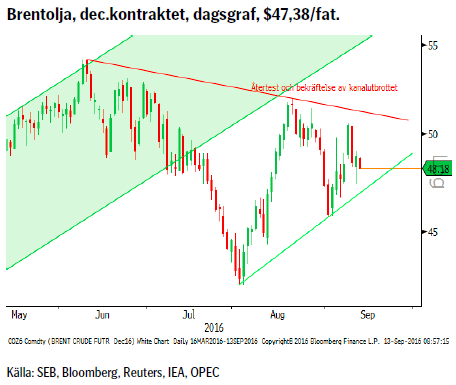 Marknaden fortsätter att uppvisa obeslutsamhet med upp och nedgångar följande på varandra. Mönstret av fallande toppar och stigande bottnar stödjer vår tes att vi bör fortsätta att intervallhandla fram tills mötet i Alger senare denna månad. Iran har nu nått samma nivå på sin produktion som när sanktionerna slog till och produktionsökningen verkar nu också ha planat ut. Målet verkar dock vara satt till ~4 mfpd något som antagligen tar ytterligare några månader att nå. Någon form av ”frysning” verkar i sådana fall vara troligare på nästa ordinarie OPEC möte som hålls den sista november i Wien.
Marknaden fortsätter att uppvisa obeslutsamhet med upp och nedgångar följande på varandra. Mönstret av fallande toppar och stigande bottnar stödjer vår tes att vi bör fortsätta att intervallhandla fram tills mötet i Alger senare denna månad. Iran har nu nått samma nivå på sin produktion som när sanktionerna slog till och produktionsökningen verkar nu också ha planat ut. Målet verkar dock vara satt till ~4 mfpd något som antagligen tar ytterligare några månader att nå. Någon form av ”frysning” verkar i sådana fall vara troligare på nästa ordinarie OPEC möte som hålls den sista november i Wien.
Konklusion: Sammantaget fortsatt stor osäkerhet kring oljepriset men med en viss övervikt för nedsidan på kort sikt.
OBSERVATIONER
+ Spekulationer om ett produktionstak.
+ Nigeriansk produktion störs fortsatt av oroligheterna i Nigerdeltat (militären jagar och stänger illegala raffinaderier).
+ Situationen i Venezuela fortsätter att förvärras.
+ Iransk produktion verkar ha nått en platå.
– Fortsatt överutbud.
– Saudisk produktion på rekordnivå (men bör säsongsmässigt snart börja minska då behovet av luftkonditionering avtar).
– Irakisk export förväntas öka ytterligare.
– Ökad utskeppningskapacitet bör kunna öka Libysk export (men de senaste rapporterna är tyvärr nedslående).
– Förra veckans lagerneddragning berodde på försenade fartygsleveranser pga. storm.
– Antalet amerikanska borriggar fortsätter att öka.
– Nigeriansk gerilla (Delta Avengers) har infört vapenvila.
– Lagren är fortsatt mycket stora ( över 5-års snitt).
– Det historiska säsongsmönstret talar för att en pristopp har satts under sommaren.
– Tekniskt så har vi återtestat brottet ned ur kanalen. Historiskt finns det en tendens att ett sådant beteende leder till ytterligare försäljningar.
Tillgängliga certifikat:
BULL OLJA X1, X2 ,X4, X5, & X10 S
BEAR OLJA X1, X2, X4, X5 & X10 S
ZINK LME 3M
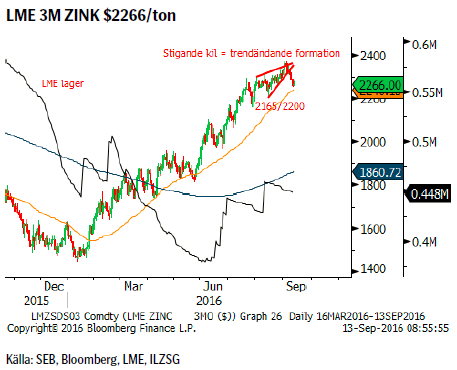 Så kom den då till slut, vändningen, korrektionen. Vi har under en tid ett flertal gånger påpekat att zinkmarknaden sprungit ifrån sig själv och att en korrektion med all nödvändighet väntat runt hörnet. Med stigande lager och en tekniskt allt mer ”stretchad” vy så har vi till slut nått en punkt där marknaden nu börjat skydda produktion/ta hem vinst på långa positioner. Givet den mycket långa nettopositionen bland kapitalförvaltare så kan en nedgång utlösa betydande försäljningar av finansiella positioner.
Så kom den då till slut, vändningen, korrektionen. Vi har under en tid ett flertal gånger påpekat att zinkmarknaden sprungit ifrån sig själv och att en korrektion med all nödvändighet väntat runt hörnet. Med stigande lager och en tekniskt allt mer ”stretchad” vy så har vi till slut nått en punkt där marknaden nu börjat skydda produktion/ta hem vinst på långa positioner. Givet den mycket långa nettopositionen bland kapitalförvaltare så kan en nedgång utlösa betydande försäljningar av finansiella positioner.
Konklusion: Flera faktorer talar för fortsatt nedåtrisk på kort sikt.
OBSERVATIONER
+ Fortsatt positiv vy på medellång – lång sikt.
+ Underskott i år och förväntat något större 2017.
+ Kinesisk fastighetsdata visar på stigande priser på nya bostäder.
+ Även bilförsäljningen är stark dock sviktar den amerikanska något.
+ Tekniskt så ligger vi medel – långsiktigt kvar i en stigande trend.
– Producentförsäljningarna har ökat ju mer priserna har klättrat.
– Ännu inga bevis på en tajtare marknad.
– LME lagren har ökat under sommaren (minskat marginellt på slutet).
– Tekniskt så har vi fallit ned från en s.k. stigande kil, ett vanligt avslutande mönster.
Tillgängliga certifikat:
BULL ZINK X1, X2, & X4 S
BEAR ZINK X2 & X4
GULD
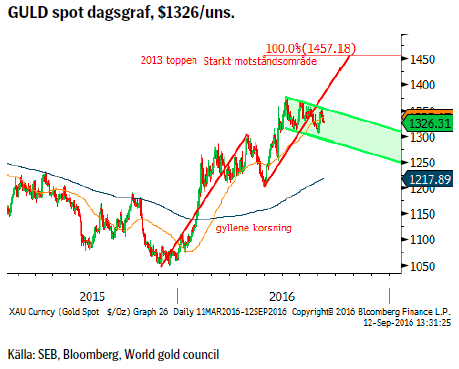 Guldet har sedan förra veckan ännu en gång testat den övre delen av den möjliga ”tjurflaggan” och ännu en gång förvägrats bryta upp ur densamma. Svagare amerikansk data och därmed uppskjuten räntehöjning sänkte dollarn och tryckte ned guldpriset men bara kortsiktigt. Guldet ser för närvarande ut att handlas ned på sämre riskaptit och stigande räntor alltså som vilken riskfylld placering som helst.
Guldet har sedan förra veckan ännu en gång testat den övre delen av den möjliga ”tjurflaggan” och ännu en gång förvägrats bryta upp ur densamma. Svagare amerikansk data och därmed uppskjuten räntehöjning sänkte dollarn och tryckte ned guldpriset men bara kortsiktigt. Guldet ser för närvarande ut att handlas ned på sämre riskaptit och stigande räntor alltså som vilken riskfylld placering som helst.
Konklusion: Fortsatt konsolidering är nog bästa gissning.
OBSERVATIONER
+ ETF-flödena vände förra veckan (statistik 2-8/9) till plus med guld och guldgruveaktierelaterade ETF:er som tredje respektive fjärde mest köpta.
+ Efterfrågan från världens 1,6miljarder muslimer kan komma att öka dramatiskt när en Sharia-standard för guld förväntas komma på plats under hösten.
+ FED’s obeslutsamhet avseende nästa räntehöjning.
+ Eventuella nya penningpolitiska stimulanser från ECB och Bank of Japan.
+ Fallande guldproduktion.
+ Statsobligationer till ett värde av $11 handlas nu till negativ ränta.
+ Det viktiga motståndsområdet i $1400-området har ännu inte utmanats.
+ Tekniskt så finns förutsättningarna för en så kallad ”tjurflagga”.
– Fortsatt positiva signaler för en starkare dollar.
– Fortsatt ökning av den nettolånga spekulativa positionen som redan är mycket stor i ett historiskt perspektiv.
– Centralbankerna har sedan i våras successivt minskat sina inköp månad för månad.
– Rekylfasen i den negativa guld/silver-trenden ser nu att ha avslutats vilket riskerar att påverka guldpriset negativt.
– Mycket tunga motstånd i $1400-området riskerar tynga.
– Tekniskt kvarstår risken för en djupare rekyl så länge inte priset klättrar upp över $1368.
Tillgängliga certifikat:
BULL GULD X1, X2, 4, 5 & 10 S
BEAR GULD X2, X4, X5 & X10 S
USD/SEK
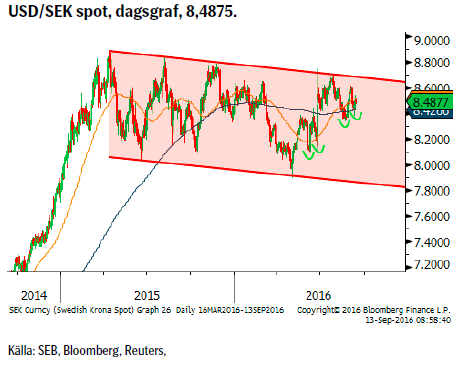 Svagare amerikansk statistik tillsammans med ett fullt inte lika mjukt Riksbanksbesked utlöste en lika snabb som kortlivad korrektion ned från 8,60 till 8,38 innan fyndköparna återvände. Sett ur en teknisk synvinkel så är det ju positivt med ännu en högre botten (även om denna inte är bekräftad innan 8,6155 bryts).
Svagare amerikansk statistik tillsammans med ett fullt inte lika mjukt Riksbanksbesked utlöste en lika snabb som kortlivad korrektion ned från 8,60 till 8,38 innan fyndköparna återvände. Sett ur en teknisk synvinkel så är det ju positivt med ännu en högre botten (även om denna inte är bekräftad innan 8,6155 bryts).
Konklusion: Fortsätter sakta men säkert att bygga upp trycket för ett brott på uppsidan.
OBSERVATIONER
+ Räntedifferensen mellan USA och Sverige bör fortsätta att öka.
+ Svensk ekonomi har börjat sakta in.
+ Dollarcykeln (sedan 1970-talet) pekar på en ny topp under 2017.
+ Positiv ränta i USA attraherar inflöden.
+ Den spekulativa långa nettopositioneringen i $-index är bara en fjärdedel av vad den var i början på året. Denna ökade dock under den senaste mätperioden.
+ Tekniskt så är konsolideringen ett fortsättningsmönster talandes för en fortsättning av den tidigare uppåttrenden.
– Att FED gång efter annan har skjutit upp räntehöjningarna.
– FED vill inte ha en allt för stark dollar.
– Osäkerhet om presidentvalet.
– Den starka dollarn är en klar motvind för amerikanska exportföretag samt att den ger en deflationsimpuls som i sin tur gör FED än mer obeslutsam.
Tillgängliga certifikat:
BULL USDSEK X1 & X4 S
BEAR USDSEK X4 S
KAFFE
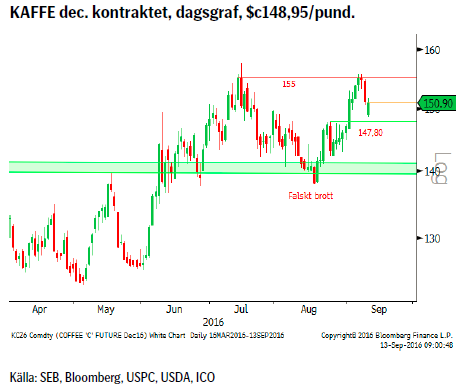 Den senaste statistiken visade på en fortsatt ökad lång nettopositionering förra veckan vilket också visade sig i initialt stigande priser. Allmän riskaptitsförsvagning i slutet på veckan påverkade dock även kaffepriset negativt.
Den senaste statistiken visade på en fortsatt ökad lång nettopositionering förra veckan vilket också visade sig i initialt stigande priser. Allmän riskaptitsförsvagning i slutet på veckan påverkade dock även kaffepriset negativt.
Konklusion: Ökad vaksamhet efter att vi återigen mött säljintressen ovanför 155-nivån. Positiv trend består ovanför 147,80.
OBSERVATIONER
+ En av de tajtaste säsongerna på länge enligt USDA,
+ Fallande global export ger farhågor om ett tajtare utbud.
+ Asiatiska producenter lider fortfarande av sviterna efter El Ninjo dvs. produktion/export är lägre än tidigare.
+ Conab’s senaste undersökning av inhemska (Brasilianska) lager visade på en minskning med 5,4 % jämfört med samma tid 2015 (generellt låga lager i producentländer).
+ Sjukdomen kafferost visade sig ha än mer långtgående konsekvenser för mexikansk produktion vilken nu beräknas fallit med en tredjedel.
+ Centralamerikansk produktion nere på 11-års lägsta.
– Fredsavtalet i Colombia bör på sikt leda till en ökad produktion/export.
– Den brasilianska valutan har fortsatt att försvagas sedan toppen i början av augusti och det ser ut att fortsätta.
– Den spekulativa nettolånga positionen nu den största sedan sommar/höst 2014.
– Generellt goda lager i konsumentländerna.
– Ånyo säljare ovanför 155-nivån.
– Tekniskt negativt om 147,80 passeras på nedsidan.
Tillgängliga certifikat:
BULL KAFFE X1, X4 & X5 S
BEAR KAFFE X4 & X5 S
OMXS30 (RENT TEKNISK UTBLICK)
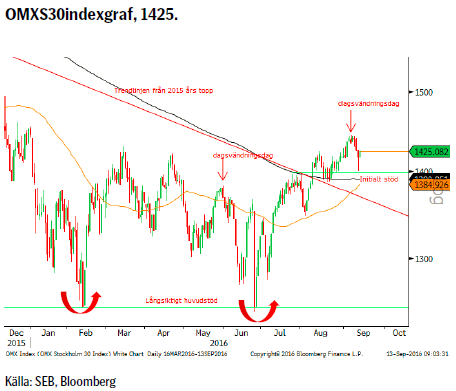 Den sjätte september utvecklades till en negativ vändningsdag (en högre topp än dagen föres högsta, en lägre botten än dagen föres lägsta och en stängning under dagen föres lägsta nivå) vilken efter de senaste dagarnas utveckling visat sig vara påfallande korrekt. Givet den tidigare positiva utvecklingen med högre toppar samt brottet över 2015 års fallande trendlinje är vi benägna att se innevarande nedgång som korrektiv dvs. tillfällig.
Den sjätte september utvecklades till en negativ vändningsdag (en högre topp än dagen föres högsta, en lägre botten än dagen föres lägsta och en stängning under dagen föres lägsta nivå) vilken efter de senaste dagarnas utveckling visat sig vara påfallande korrekt. Givet den tidigare positiva utvecklingen med högre toppar samt brottet över 2015 års fallande trendlinje är vi benägna att se innevarande nedgång som korrektiv dvs. tillfällig.
Konklusion: För att bibehålla en medelsiktigt positiv vy så bör området mellan 1397 – 1370 attrahera förnyat köpande.
OBSERVATIONER
+ Priset ligger över både 55 och 233d mv.
+ Priset har brutit över rekyltoppen från mars, 1432 och därigenom brutit mönstret av fallande toppar.
+ 55d mv har en positiv lutning.
+ Långsiktig dubbelbotten vid 1240/46 stödet.
– Starka motstånd vid 1483.
– Kortsiktigare indikatorer har vänt till sälj.
– Negativ dagsvändningsdag den 6:e sept.
Tillgängliga certifikat:
BULL OMX X5 S
BEAR OMX X5 S
INFORMATION OM REKOMMENDATIONER
Denna publikation är ett marknadsföringsmaterial för SEBs certifikat-produkter. I och med den nya Marknadsmissbruksförordningen vilken trädde i kraft den tredje juli 2016 har vi inte längre möjlighet att inkludera investeringsrekommendationer rörande certifikat-produkterna.
UTVECKLING SENASTE VECKAN SAMT SEDAN ÅRETS BÖRJAN
[box]SEB Veckobrev Veckans råvarukommentar är producerat av SEB:s Commodities Sales desk och publiceras i samarbete och med tillstånd på Råvarumarknaden.se[/box]
KÄLLOR
Bloomberg, Reuters, SEB
VILLKOR
För varje enskilt certifikat/mini future finns Slutliga Villkor som anger de fullständiga villkoren. Slutliga Villkor finns tillgängligt på kurssidan för respektive certifikat/mini future på www.seb.se, Börs & finans, fliken Strukturerade placeringar.
RISKER
En sammanfattning av de risker som är förknippade med Börshandlade certifikat generellt finns i Produktbroschyren för respektive certifikat eller mini future som är tillgängligt på seb.se/cert respektive seb.se/mini. För en fullständig bild av riskerna behöver du ta del av SEB:s offentliggjorda Grundprospekt för Certifikat- och Warrantprogram som är publicerat på www.seb.se/cert respektive seb.se/mini.
DISCLAIMER
Detta marknadsföringsmaterial, framtaget av SEB:s Commodities Sales desk, har upprättats enbart i informationssyfte.
Även om innehållet är baserat på källor som SEB bedömt som tillförlitliga ansvarar SEB inte för fel eller brister i informationen. Den utgör inte oberoende, objektiv investeringsanalys och skyddas därför inte av de bestämmelser som SEB har infört för att förebygga potentiella intressekonflikter. Yttranden från SEB:s Commodities Sales desk kan vara oförenliga med tidigare publicerat material från SEB, då den senare hänvisas uppmanas du att läsa den fullständiga rapporten innan någon åtgärd vidtas.
Dokumentationen utgör inte någon investeringsrådgivning och tillhandahålls till dig utan hänsyn till dina investeringsmål. Du uppmanas att självständigt bedöma och komplettera uppgifterna i denna dokumentation och att basera dina investeringsbeslut på material som bedöms erforderligt. Alla framåtblickande uttalanden, åsikter och förväntningar är föremål för risker, osäkerheter och andra faktorer och kan orsaka att det faktiska resultatet avviker väsentligt från det förväntade. Historisk avkastning är ingen garanti för framtida resultat. Detta dokument utgör inte ett erbjudande att teckna några värdepapper eller andra finansiella instrument. SEB svarar inte för förlust eller skada – direkt eller indirekt, eller av vad slag det vara må – som kan uppkomma till följd av användandet av detta material eller dess innehåll.
Observera att det kan förekomma att SEB, dess ledamöter, dess anställda eller dess moder- och/eller dotterbolag vid olika tillfällen innehar, har innehaft eller kommer att inneha aktier, positioner, rådgivningsuppdrag i samband med corporate finance-transaktioner, investment- eller merchantbanking-uppdrag och/eller lån i de bolag/finansiella instrument som nämns i materialet.
Materialet är avsett för mottagaren, all spridning, distribuering mångfaldigande eller annan användning av detta meddelande får inte ske utan SEB:s medgivande. Materialet riktar sig inte till personer vars medverkan kräver ytterligare prospekt, registrerings- eller andra åtgärder än vad som följer av svensk rätt. Det åligger var och en att iaktta sådana restriktioner. Materialet får inte distribueras i eller till land där distribution kräver ovan nämnda åtgärder eller strider mot reglering i sådant land. Materialet riktar sig således inte till fysiska eller juridiska personer hemmahörande i USA eller i något annat land där publicering eller tillhandahållande av materialet är förbjudet eller strider mot tillämpliga bestämmelser i landet.
Oaktat detta får SEB tillåta omfördelning av materialet till utvald tredje part i enlighet med gällande avtal. Materialet får inte spridas till fysiska eller juridiska personer som är medborgare eller har hemvist i ett land där sådan spridning är otillåten enligt tillämplig lag eller annan bestämmelse.
Skandinaviska Enskilda Banken AB (publ) är ett publikt aktiebolag och står under tillsyn av Finansinspektionen samt de lokala finansiella tillsynsmyndigheter i varje jurisdiktionen där SEB har filial eller dotterbolag.
Analys
Tightening fundamentals – bullish inventories from DOE

The latest weekly report from the US DOE showed a substantial drawdown across key petroleum categories, adding more upside potential to the fundamental picture.

Commercial crude inventories (excl. SPR) fell by 5.8 million barrels, bringing total inventories down to 415.1 million barrels. Now sitting 11% below the five-year seasonal norm and placed in the lowest 2015-2022 range (see picture below).
Product inventories also tightened further last week. Gasoline inventories declined by 2.1 million barrels, with reductions seen in both finished gasoline and blending components. Current gasoline levels are about 3% below the five-year average for this time of year.
Among products, the most notable move came in diesel, where inventories dropped by almost 4.1 million barrels, deepening the deficit to around 20% below seasonal norms – continuing to underscore the persistent supply tightness in diesel markets.
The only area of inventory growth was in propane/propylene, which posted a significant 5.1-million-barrel build and now stands 9% above the five-year average.
Total commercial petroleum inventories (crude plus refined products) declined by 4.2 million barrels on the week, reinforcing the overall tightening of US crude and products.


Analys
Bombs to ”ceasefire” in hours – Brent below $70

A classic case of “buy the rumor, sell the news” played out in oil markets, as Brent crude has dropped sharply – down nearly USD 10 per barrel since yesterday evening – following Iran’s retaliatory strike on a U.S. air base in Qatar. The immediate reaction was: “That was it?” The strike followed a carefully calibrated, non-escalatory playbook, avoiding direct threats to energy infrastructure or disruption of shipping through the Strait of Hormuz – thus calming worst-case fears.

After Monday morning’s sharp spike to USD 81.4 per barrel, triggered by the U.S. bombing of Iranian nuclear facilities, oil prices drifted sideways in anticipation of a potential Iranian response. That response came with advance warning and caused limited physical damage. Early this morning, both the U.S. President and Iranian state media announced a ceasefire, effectively placing a lid on the immediate conflict risk – at least for now.
As a result, Brent crude has now fallen by a total of USD 12 from Monday’s peak, currently trading around USD 69 per barrel.
Looking beyond geopolitics, the market will now shift its focus to the upcoming OPEC+ meeting in early July. Saudi Arabia’s decision to increase output earlier this year – despite falling prices – has drawn renewed attention considering recent developments. Some suggest this was a response to U.S. pressure to offset potential Iranian supply losses.
However, consensus is that the move was driven more by internal OPEC+ dynamics. After years of curbing production to support prices, Riyadh had grown frustrated with quota-busting by several members (notably Kazakhstan). With Saudi Arabia cutting up to 2 million barrels per day – roughly 2% of global supply – returns were diminishing, and the risk of losing market share was rising. The production increase is widely seen as an effort to reassert leadership and restore discipline within the group.
That said, the FT recently stated that, the Saudis remain wary of past missteps. In 2018, Riyadh ramped up output at Trump’s request ahead of Iran sanctions, only to see prices collapse when the U.S. granted broad waivers – triggering oversupply. Officials have reportedly made it clear they don’t intend to repeat that mistake.
The recent visit by President Trump to Saudi Arabia, which included agreements on AI, defense, and nuclear cooperation, suggests a broader strategic alignment. This has fueled speculation about a quiet “pump-for-politics” deal behind recent production moves.
Looking ahead, oil prices have now retraced the entire rally sparked by the June 13 Israel–Iran escalation. This retreat provides more political and policy space for both the U.S. and Saudi Arabia. Specifically, it makes it easier for Riyadh to scale back its three recent production hikes of 411,000 barrels each, potentially returning to more moderate increases of 137,000 barrels for August and September.
In short: with no major loss of Iranian supply to the market, OPEC+ – led by Saudi Arabia – no longer needs to compensate for a disruption that hasn’t materialized, especially not to please the U.S. at the cost of its own market strategy. As the Saudis themselves have signaled, they are unlikely to repeat previous mistakes.
Conclusion: With Brent now in the high USD 60s, buying oil looks fundamentally justified. The geopolitical premium has deflated, but tensions between Israel and Iran remain unresolved – and the risk of missteps and renewed escalation still lingers. In fact, even this morning, reports have emerged of renewed missile fire despite the declared “truce.” The path forward may be calmer – but it is far from stable.
Analys
A muted price reaction. Market looks relaxed, but it is still on edge waiting for what Iran will do

Brent crossed the 80-line this morning but quickly fell back assigning limited probability for Iran choosing to close the Strait of Hormuz. Brent traded in a range of USD 70.56 – 79.04/b last week as the market fluctuated between ”Iran wants a deal” and ”US is about to attack Iran”. At the end of the week though, Donald Trump managed to convince markets (and probably also Iran) that he would make a decision within two weeks. I.e. no imminent attack. Previously when when he has talked about ”making a decision within two weeks” he has often ended up doing nothing in the end. The oil market relaxed as a result and the week ended at USD 77.01/b which is just USD 6/b above the year to date average of USD 71/b.

Brent jumped to USD 81.4/b this morning, the highest since mid-January, but then quickly fell back to a current price of USD 78.2/b which is only up 1.5% versus the close on Friday. As such the market is pricing a fairly low probability that Iran will actually close the Strait of Hormuz. Probably because it will hurt Iranian oil exports as well as the global oil market.
It was however all smoke and mirrors. Deception. The US attacked Iran on Saturday. The attack involved 125 warplanes, submarines and surface warships and 14 bunker buster bombs were dropped on Iranian nuclear sites including Fordow, Natanz and Isfahan. In response the Iranian Parliament voted in support of closing the Strait of Hormuz where some 17 mb of crude and products is transported to the global market every day plus significant volumes of LNG. This is however merely an advise to the Supreme leader Ayatollah Ali Khamenei and the Supreme National Security Council which sits with the final and actual decision.
No supply of oil is lost yet. It is about the risk of Iran closing the Strait of Hormuz or not. So far not a single drop of oil supply has been lost to the global market. The price at the moment is all about the assessed risk of loss of supply. Will Iran choose to choke of the Strait of Hormuz or not? That is the big question. It would be painful for US consumers, for Donald Trump’s voter base, for the global economy but also for Iran and its population which relies on oil exports and income from selling oil out of that Strait as well. As such it is not a no-brainer choice for Iran to close the Strait for oil exports. And looking at the il price this morning it is clear that the oil market doesn’t assign a very high probability of it happening. It is however probably well within the capability of Iran to close the Strait off with rockets, mines, air-drones and possibly sea-drones. Just look at how Ukraine has been able to control and damage the Russian Black Sea fleet.
What to do about the highly enriched uranium which has gone missing? While the US and Israel can celebrate their destruction of Iranian nuclear facilities they are also scratching their heads over what to do with the lost Iranian nuclear material. Iran had 408 kg of highly enriched uranium (IAEA). Almost weapons grade. Enough for some 10 nuclear warheads. It seems to have been transported out of Fordow before the attack this weekend.
The market is still on edge. USD 80-something/b seems sensible while we wait. The oil market reaction to this weekend’s events is very muted so far. The market is still on edge awaiting what Iran will do. Because Iran will do something. But what and when? An oil price of 80-something seems like a sensible level until something do happen.
-

 Nyheter3 veckor sedan
Nyheter3 veckor sedanStor uppsida i Lappland Guldprospekterings aktie enligt analys
-

 Nyheter4 veckor sedan
Nyheter4 veckor sedanBrookfield ska bygga ett AI-datacenter på hela 750 MW i Strängnäs
-
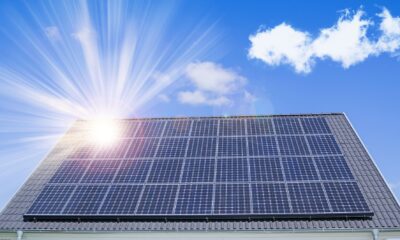
 Nyheter4 veckor sedan
Nyheter4 veckor sedanSommaren inleds med sol och varierande elpriser
-

 Nyheter4 veckor sedan
Nyheter4 veckor sedanOPEC+ ökar oljeproduktionen trots fallande priser
-

 Nyheter3 veckor sedan
Nyheter3 veckor sedanSilverpriset släpar efter guldets utveckling, har mer uppsida
-

 Analys4 veckor sedan
Analys4 veckor sedanBrent needs to fall to USD 58/b to make cheating unprofitable for Kazakhstan
-

 Nyheter4 veckor sedan
Nyheter4 veckor sedanTradingfirman XTX Markets bygger datacenter i finska Kajana för 1 miljard euro
-

 Nyheter2 veckor sedan
Nyheter2 veckor sedanUppgången i oljepriset planade ut under helgen


